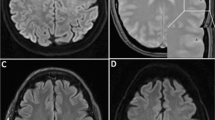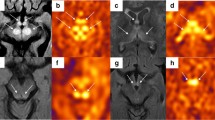Abstract
Serial MRI findings are described in two patients with Reye's syndrome, demonstrating diffuse cortical and white matter changes. In the acute stage, T2-weighted images showed subtle but definite laminar high signal and contrast-enhanced T1-weighted images laminar enhancement, along the entire cerebral cortexbilateraly. In the chronic stage, unenhanced T1-weighted images showed diffuse cortical laminar high signal. These characteristic MRI features seemed very similar to those of laminar cortical necrosis in hypoxic brain damage. MRI also displayed delayed white matter changes with cerebral atrophy.
Similar content being viewed by others
References
Reye RDK, Morgan G, Baral J (1963) Encephalopathy and fatty degeneration of the viscera: a disease entity in childhood. Lancet II: 749–752
Duchen LW, Jacobs JM (1992) Nutritional deficiencies and metabolic disorders. In: Adams JH, Corsellis JAN, Duchen LW (eds) Greenfield's neuropathology, 5th edn. Arnold, London, pp 811–880
DeLong GR, Glick TH (1982) Encephalopathy of Reye's syndrome: a review of pathogenetic hypotheses. Pediatrics 69:53–63
Brown JK, Imam H (1991) Interrelationships of liver and brain with special reference to Reye syndrome. J Inherit Metab Dis 14:436–458
Svoboda DJ, Reddy LK (1975) Pathology of the liver in Reye's syndrome. Lab Invest 32:571–579
Ruskin AR, Haughton VM (1985) CT findings in adult Reye syndrome. AJNR 6:446–447
Giannotta SL, Hopkins J, Kindt GW (1978) Computerized tomography in Reye's syndrome: evidence for pathological cerebral vasodilation. Neurosurgery 2:201–204
Russel EJ, Zimmerman RD, Leeds NE, French J (1979) Reye syndrome: documentation of disordered intracerebral structure. J Comput Assist Tomogr 3: 217–220
Coin CG, Pennink M, Gray R, Stowe F (1979) Cerebral computed tomography in Reye syndrome. J Comput Assist Tomogr 3:276–277
Aoki N (1985) Acute toxic encephalopathy with symmetrical low density areas in the thalami and the cerebellum. Child's Nerv Syst 1:62–65
Partin JC, Partin JS, Schubert WK, McLaurin RL (1975) Brain ultrastructure in Reye's syndrome (encephalopathy and fatty alteration of the viscera). J Neuropath Exp Neurol 34:425–444
Manz HJ, Colon AR (1982) Neuropathology, pathogenesis, and neuropsychiatric sequelae of Reye syndrome. J Neurol Sci 53:377–395
Sawada H, Udaka F, Seriu N, Shindou K, Kameyama M, Tsujimura M (1990) MRI demonstration of cortical laminar necrosis and delayed white matter injury in anoxic encephalopathy. Neuroradiology 32:319–321
Takahashi S, Higano S, Ishii K, Matsumoto K, Sakamoto K, Iwasaki Y, Suzuki M (1993) Hypoxic brain damage: cortical laminar necrosis and delayed changes in white matter at sequential MR imaging. Radiology 189: 449–456
Dietrich RB, Bradley WG (1988) Iron accumulation in the basal ganglia following severe ischemic-anoxic insults in children. Radiology 168:203–206
Author information
Authors and Affiliations
Rights and permissions
About this article
Cite this article
Kinoshita, T., Takahashi, S., Ishii, K. et al. Reye's syndrome with cortical laminar necrosis: MRI. Neuroradiology 38, 269–272 (1996). https://doi.org/10.1007/BF00596545
Received:
Accepted:
Issue Date:
DOI: https://doi.org/10.1007/BF00596545




